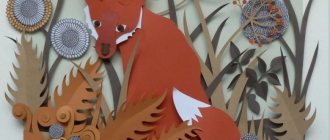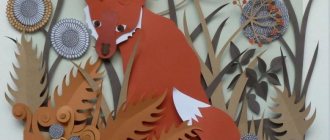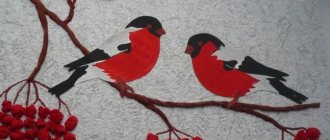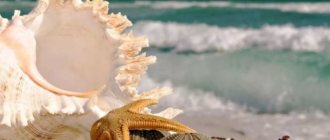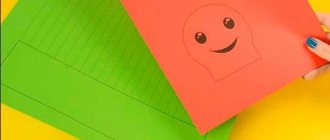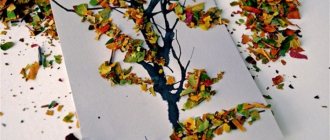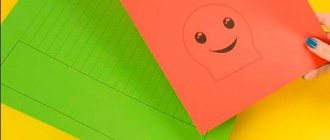Children of any age can make applique animals. As a rule, children are very interested in such crafts. You just need to choose the right level of difficulty for each age group of children.
To make all applications you will need the following tools and materials:
- stationery glue or glue stick,
- simple pencil,
- ruler,
- scissors,
- cardboard,
- colored paper of various colors,
- multi-colored felt-tip pens or markers
- ready-made paper templates.
Animal applications for children under 3 years old
For very young children, flat animal applications made from geometric shapes - circles, ovals, triangles, rectangles and squares - are suitable. At the same time, this will allow you to get acquainted with these figures in a playful way and learn how to work with them.
Before working with your child, all elements should already be cut out of paper. It is advisable to show the child a drawing of the finished application and, naming the figures on it, invite him to choose similar figures from several different ones. Draw the child's attention to the importance of color.
Next, tell us in what order you need to assemble the applique and show how to apply the glue correctly. You need to start working with animals that are well known to the child, for example, a dog, a cat or a bird.
In the future, it will be possible to offer the creation of images of other domestic and then wild animals. It is important to focus the baby’s attention on the distinctive features of each animal that make it recognizable.
For younger children, the application should consist of large parts and a small number of elements, so that children do not lose interest in the process.
Motivation for visual activities
Children in the older group perceive the teacher not only as a source of information, but also as a friend and interlocutor. The best motivation for depicting animals will be to appeal to the experience of the students, their feelings and emotions. Surely the children have experience communicating with animals; many have pets at home, they have seen cattle in the village, and wild animals in the zoo, on TV. A conversation about these impressions will help the teacher direct activities in the right direction and create a trusting atmosphere in the lesson.
In addition, they use visualization (object and plot pictures, excerpts from cartoons, videos with animals), artistic expression (riddles, poems, fragments of stories and fairy tales about animals), playful and surprise moments, problematic situations, for example:
- Lesovichok comes to the children. He is very upset, because winter has come (the class is held in winter), and many of the inhabitants of the forest have fallen into hibernation. And Lesovichok misses his friends so much! He doesn't even have their portraits. The teacher invites the children to cheer up Lesovich by making portraits of forest animals that hibernate as souvenirs.
- A learned gnome sends a letter to the group. His little grandson cannot remember the names and types of animals in hot countries. The learned gnome asks the children to make a large, interesting picture with several animals from the tropics. Children discuss the problem and decide to make a collective applique with the image of a giraffe, zebra, elephant, rhinoceros, etc.
- Their favorite fairy-tale character (Dunno, Carlson, etc.) comes to the children. He reports that he has a pet, describes it, asks the children if they have pets, who they would like to have, what funny habits the animals have, and then invites the children to portray their favorite animal. This theme helps to unleash the imagination and creativity of children, and there is nothing wrong with little ones portraying puppies with wings or lilac and pink kittens, because they are not just conveying images of existing animals, but their dreams. In such work, it is good to combine appliqué and drawing, that is, the children paste the silhouette of the animal and draw the details.
Educators should remember that fish, birds, insects, and reptiles are also animals and their depiction will not be a mistake.
In any case, it is worth considering that children in the older group are looking for a partner, a friend in a teacher, so it is necessary to treat their ideas and proposals with understanding and interest, to support and develop manifestations of initiative, original thinking, and self-expression.
What is most important in visual arts is the joy of free creativity.
Paper animal applications step by step
Children in the middle group can be asked to make an applique of the following domestic and wild animals from scratch:
cat
You can offer to make a cat for the youngest children who are just learning to work with scissors.
First, you need to invite the child to choose the color of the future cat and draw on paper of that color a head - a circle, a body - an oval, ears - triangles, paws - elongated rectangles and a tail - an arc.
Then you need to cut them out and assemble them into a finished animal on a sheet of thick paper or cardboard. In conclusion, draw the muzzle.
Piglet
The piglet is made in the same way as a cat. But for recognition, in addition to the pink color, the body needs to be made thicker and more voluminous, and the legs thinner and smaller. They should end in hooves.
You need to glue a white or red circle - a snout - onto the muzzle, and make the tail curl. Older children can make this voluminous craft from rolled paper.
Dog
For small children, it is better to print out a dog template. The animal on it can be of any breed, in full face or profile, or just a close-up portrait. You just need to follow the rule - the smaller the child, the larger the parts.
The template must be cut into separate parts, traced around them like patterns on paper of the desired color and cut out. Then glue the cut out parts onto a sheet of thick paper or cardboard and draw a face, eyes and mustache.
Cow
The youngest children need to be given ready-made parts for gluing. Older children can draw them according to a template and cut them out themselves, as well as make a composition of several cows grazing in a meadow.
We need to draw children's attention to the fact that one of the most recognizable features of a cow is its large contrasting spots.
Lion cub
For the lion cub you will need yellow and orange paper, plastic eyes and a template. You need to trace according to the template on yellow paper and cut everything out according to the template. Then cut a wide strip from the orange one and cut it crosswise into narrow “noodles”, not cutting through the strip all the way.
Next, take a circle of yellow paper that will serve as the head, and stick a cut strip of “noodles” onto it around the perimeter on the back side. Glue the lion cub's tail to a piece of cardboard first, then the body, front paws and finally the head. Glue on the eyes, draw a muzzle and mustache.
Penguin
The little penguin is suitable for children of the middle group. To create it you will need black, white and orange paper. From black you need to cut out a large oval for the body and elongated triangles for the wings.
From white - a small oval for the chest and a circle for the head. The orange one has a triangular beak and flippers. All parts must be well glued to the base.
Dragon
To make a dragon you will need green and some yellow paper. On the red one you need to draw 4 large circles using a template and cut them out. Then fold each circle in half and cut. And fold each half in half, the colored side inward.
Glue together quartered circles in pairs to form a book. Glue it with the “cover” pages to a sheet of paper. The result is the body of a dragon. Using the template, draw and cut out a head with a neck and a tail from red paper. Glue them on opposite sides of the body.
Using the neck template, draw and cut out a semicircular strip from yellow paper. To turn it into the comb of our dragon, cut out the cloves in its upper part. Cut out several yellow circles.
Glue the comb to the neck, and the circles all over the dragon's body, including the neck and tail. Draw the eyes and teeth of the dragon.
Master class volumetric applique “Walrus”
Tamara Kudukova
Master class volumetric applique “Walrus”
Who is he, fat gentleman,
What is lying among the ice floes?
Mustache, fangs and thick skin,
Well, of course, it's a walrus .
Recently, interest in the Artik has been growing; a lot of research has been carried out to study the climate, vegetation, and fauna. One of the unique animals is the walrus . From the small head, relative to the body, two powerful tusks protrude downwards; the animal needs them for defense and for obtaining food from the bottom, and with their help it can also climb onto ice floes.
Goal: To expand children’s understanding of the lifestyle of some animals of the North. Run the application .
Introduce children to the animals of the North (talk about walruses , what they eat, where they live, etc.)
Cultivate a love for animals
Activate and expand your vocabulary (clumsy, thick)
Develop fine motor skills of hands
Develop imagination and creativity.
Materials for application :
white cardboard (for template)
Work progress: Take white cardboard and draw the details, and then cut them out. The result is a template.
Next, take colored paper, glue and scissors and move on to our applique
"New Year cards". Master class in the “volumetric applique” technique Greetings to all guests of my page! Happy New Year! Let me introduce you to a few ideas for New Year's cards. Necessary. "Thoughtful sheep." Master class in the “volumetric applique” technique Hello, dear friends and colleagues! We completely forgot about the sheep! But soon we will say goodbye to it! I present to you a master class. Master class for children “Volume application “New Year tree” Master class for children 3D application “New Year tree” For work we will need: two-layer packaging cardboard; colored. Master class for children “Volume application “Snow Globe” Master class for children 3D application “Snow Globe” Materials for our work Colored cardboard (blue or light blue).
Source
Animal appliques made from accordion paper
It’s just as easy to make animal appliqués from accordion paper. First, children need to be explained how to fold an accordion out of paper. This application will be interesting in the middle group and is suitable for the theme of domestic or wild animals. There are several ways to make such crafts:
- An accordion fan. If you glue an accordion on one side, you get a fan. The easiest way to make a hedgehog is based on it. The paper fan will represent a body with needles. To its base you need to glue a semi-oval made of paper with a drawn muzzle and two legs to it from below.
- Accordion circle. By gluing two fans together, we get a circle. It can act as a body for a pig, a mane for a lion or a face for appliqué of any other animals. The missing body parts need to be glued to it.
- Straight accordion. It will serve as a body to which you can glue the head, legs and tail - you will get an applique of any wild or domestic animals. You just need to choose the desired color of paper and add a face to the finished application.
Explanation of the application execution procedure
In order for children to complete their work successfully and enjoy the activity, the teacher needs to clearly and clearly explain the procedure. It will depend on the choice of techniques, materials, and whether preschoolers work together or individually.
Almost all instructions are accompanied by a demonstration of intermediate stages of work, but for some types of application this is not possible, for example, recently glued cereal will fall off the sheet if it is placed in a vertical position. Children need to be introduced to such techniques in advance, in their free time, and then verbal instructions will be sufficient during the lesson.
Item trim applique
The most common method is subject application. It helps to develop skills in using scissors and paper, and gives the teacher the opportunity to see which of the children successfully cope with program tasks and which need individual help. Algorithm for making paper trim applique:
- Each child completes the applique on a separate sheet.
- We prepare parts depending on the selected animal.
- We lay out the details on the background so that the image is in the center; you can use the sample.
- We glue it in this order: body, head, paws, tail, small details (ears, eyes, mouth). You can draw faces with felt-tip pens or pencils. Smooth it out with a napkin.
- If desired, decorate the background with snow, grass, flowers, etc.
Photo gallery: finished works using the cut applique technique
The children complemented the squirrel figurine with a design of a pine branch and a foil nut.
The image of a cat consists of ovals and circles, which the preschooler needs to cut out from squares
The “Elephant” applique uses many additional decorative details, so it is better to divide it into two classes or between two children
A child of the sixth year of life can make this figurine of a fox independently.
Making a collective silhouette applique
All children in the group participate in the collective application. If the group is large, it is divided into two subgroups. The work is performed in the following order:
- We attach the stencil or template to a sheet of paper. If the paper is not double-sided colored, choose the white side.
- We outline the image of the animal.
- Cut along the contour.
- We turn it over, glue it or add details.
- Turn it over again and apply glue along the edge of the silhouette.
- We choose a place for the figure on a common sheet, glue it, smooth it with a napkin.
Usually, in group work, children in the older group already agree themselves who will place their parts of the image and where. For those who can do it faster, the teacher offers to decorate the background by gluing small decorative elements (large ones are glued in advance, before class).
Photo gallery: examples of collective works using the silhouette appliqué technique
An applique on the theme “Farm” can also be made using the collage technique, using clippings from magazines or printed images of characters
The panel “Sheep in the Meadow” combines silhouette and mosaic appliqué techniques
The funny penguins on this applique are made according to a template and complemented with trimmed details
Collective works depicting animals from hot countries also look great, because their silhouettes are easily recognizable and varied.
Performing mosaic applications in pairs or subgroups
Children receive sheets with ready-made animal outlines. The materials for the mosaic are scraps of paper, balls from napkins (pupils roll them up in advance in their free time), cereals, padding polyester or cotton wool, poplar fluff, and plant seeds. The work flow is as follows:
- The image is coated with glue in small areas, starting from the top.
- They glue the materials, guided by the ready-made sample and the teacher’s advice.
- Allow the appliqué to dry and then remove excess materials, carefully shaking them onto a scrap plate.
- Finish drawing or gluing on details.
Mosaic application is the most labor-intensive, requiring perseverance, painstakingness and patience, so for it you need to choose the simplest images with large parts.
Photo gallery: finished works and templates for mosaic application
This bunny made of cotton wool and cotton balls was made collectively
Mosaic applique “Fox” can be done by one or two older children
The giraffe from the cereal will be erased very positively and colorfully
When looking for applique templates on the Internet, you should pay attention to the numerous coloring books for kids
With such positive animal templates, the application will turn into a fun game.
When making cereal appliqué using this template, it is better to finish the tail and horns or use threads or ribbon
Application from ready-made elements
This type of application is the simplest; image preparation is minimal. It requires cotton pads, leaves, geometric shapes. Children may only need to cut and bend the finished pieces in half. The main thing that is needed is the ability to compose and design a beautiful composition. Planar design skills are already required here. Students love this technique because almost everyone can do it, and the finished work has a very attractive, impressive appearance.
An application made from ready-made forms can become an illustration for your favorite fairy tale or cartoon
In an appliqué made from ready-made parts, even one child can depict several figures, part of a landscape, an animal’s home, or illustrate an episode of a favorite fairy tale. This type of application is also suitable for working together. How to perform this application:
- We think about what we will place and where, which parts will be useful intact, and which need to be cut and bent.
- We bend and cut, if necessary, some elements.
- We lay out the parts of the application on the background, forming a completely finished composition.
- We take each part in turn, spread glue along the edge and put it in the same place where it was. Gently smooth it through a napkin (dry leaves and twigs do not need to be smoothed, children pay attention to this).
- We decorate with small elements.
Photo gallery: samples of applications from ready-made forms
An application can consist of only circles, but at the same time it can be difficult to complete, requiring attention and the ability to select colors
To convey the image of a puppy, children need to think about how to position the tail and ears, because the hero’s emotions depend on this. The lamb in the meadow was made from cotton pads and cotton swabs, complementing the composition with ready-made flowers on an adhesive base
An original cat made from cotton pads will decorate a corner of nature
Children can make these hares in pairs
The elephant figurine will require preschoolers to diligently convey the shape of the legs and trunk
Ready-made shapes combined with silhouette cutting created a wonderful picture of a summer farm
By gluing the “needles” of this hedgehog, children coordinate their actions so that the animal looks smart and neat
Volumetric animal applications
There are several ways to make a three-dimensional paper applique:
- Strip applique. To use this method, you need to glue the animal’s body together from narrow strips, like a flashlight. And glue a paper head, legs and tail to it. You can make a whole exhibition of works on such an application in the senior group - for example, on the topic “Animals of the North”. You can invite children to make one of the following animals: deer, wolf, polar bear or owl.
- Cone applique. Cone-based applications are perfect for developing children's imagination. For example, for children in the preparatory group, you can suggest a theme for the application “Animals of hot countries.” Children can make a tiger, lion, giraffe, elephant or crocodile. The cone can act as a head, torso, or any other part of the body. For younger children, the cutting of the cone should already be ready, and a sample should be provided for copying.
- Cylinder applique. The scheme is the same as in the previous versions, but this craft is easier to make. Plus, absolutely any animal can be made this way.
Organization of an application on the theme “Animals” in the senior group
An application on the topic “Wild and Domestic Animals” in the senior group is a great way not only to consolidate the knowledge, skills and abilities of children, but also to help foster love for our smaller brothers, kindness and humanity. By developing these qualities in students, teachers help children socialize and establish relationships with others, which is especially important for future schoolchildren.
Having chosen which animal the children will portray, the teacher must first think through the following questions:
- Will it be a subject (one animal) or a plot application. In the second case, several characters and additional details are required (shed, kennel, image of a forest clearing, etc.), which also need to be prepared. It is very difficult for one child to make a trimmed or mosaic plot applique, but if it is an applique from ready-made forms, it is quite possible.
- How many children will work on the work. It is possible to make an application by one child, in a pair, in a small subgroup (3–6 people), or by the whole team. Collective work is appropriate if the work is voluminous or complex (collage, mosaic, combination of various techniques).
- Application size. It can be done on standard A4 sheets if 1-2 children are working, but for collective and subgroup applications it is better to take A3 sheets, the kids will be able to sit comfortably around them and create a composition without interfering with each other. The details should be of such a size that the entire image looks harmonious.
There should be enough space on the sheet not only for the animal itself, but also for the accompanying parts
The application must be made accessible to every child, that is, tasks must be individualized depending on the level of preparation and abilities of the children. After all, children have different skills and pace of activity. Some cope faster and may get bored, others have difficulty using scissors and cutting techniques. This is especially true for newcomers who came to the senior group from home. Such children can be offered ready-made parts, templates or stencils, while their more prepared peers make appliqué parts on their own, using previously acquired skills. For those who can do it faster, you can offer an additional amount of work: decorate the background with details, draw or stick on food for the animal, and other small elements.
Animal leaf appliques
In this type of application, the selection of material is important. It is best to store leaves in the fall - then there is an opportunity to collect material of various shades, especially warm tones. The leaves need to be straightened and placed between the pages of a large format book.
They must remain there until completely dry, otherwise the leaves will curl. It is better to collect leaves together with children, simultaneously explaining to them where each tree is and telling them about them.
Working with leaves is practically no different from working with paper, except that dry leaves are quite fragile and they do not stick well. Application of leaves develops the child's imagination.
He learns about the properties of natural materials and learns to work with them, compares the shape and color of various objects.
Fabric animal appliques
Fabric appliqués are usually used as decoration for clothing or other textiles. They can be made by older children who are familiar with the technique of sewing by machine or by hand.
The principle of operation is the same as for paper, except that such an applique is sewn on rather than glued, and when working with loose fabrics it is necessary to overcast the edge.
The design is transferred to dark fabrics not with a pencil, but with a piece of soap. You can use contrasting threads to “draw” the face or highlight the outline of the animal. The child will be happy to wear something decorated with his own hands.
Applications of animals from cotton wool
Cotton wool is a good material for applique, perfectly conveying animal hair. To work with it, children need to draw the outline of an animal.
It needs to be filled with cotton wool close to the texture of the fur of a particular animal: for a sheep - with lumps, for a dog - with narrow hanging strips, etc. If desired, this “wool” can be painted.
It is quite possible to simply cut out some of the elements from paper and stick them on.
Animal applications using quilling technique
Quilling is an application of increased complexity. The work consists of gluing narrow strips of paper, usually folded in the form of spirals, onto cardboard.
First, the outline of the animal is glued, and then it is filled from the inside with curls of the desired shade. This technique is good because it successfully imitates the texture of animal fur or bird feathers.
All children, without exception, love creativity. Therefore, appliqué is one of the most interesting hobbies. Children work with her with great pleasure both in kindergarten and at home. Not only is it a wonderful leisure activity for a child, but it also develops his imagination.
